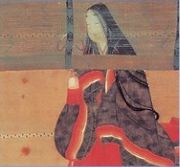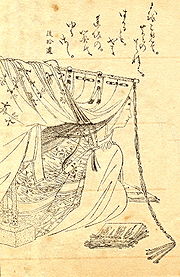
Sei Shonagon
Encyclopedia



Lady-in-waiting
A lady-in-waiting is a female personal assistant at a royal court, attending on a queen, a princess, or a high-ranking noblewoman. Historically, in Europe a lady-in-waiting was often a noblewoman from a family highly thought of in good society, but was of lower rank than the woman on whom she...
who served the Empress Teishi (Sadako) around the year 1000 during the middle Heian period
Heian period
The is the last division of classical Japanese history, running from 794 to 1185. The period is named after the capital city of Heian-kyō, or modern Kyōto. It is the period in Japanese history when Buddhism, Taoism and other Chinese influences were at their height...
. She is best known as the author of The Pillow Book
The Pillow Book
is a book of observations and musings recorded by Sei Shōnagon during her time as court lady to Empress Consort Teishi during the 990s and early 11th century in Heian Japan. The book was completed in the year 1002....
(枕草子 makura no sōshi).
Name
Sei Shōnagon's actual given name is not known. It was the custom among aristocrats in those days to call a court lady (女房nyōbō) by a nickname taken from her clan name or a court office belonging either a close male relative. Sei (清) derives from the Kiyohara (清原) clan, while ShōnagonShōnagon
Shōnagon was a counselor of the third rank in the Imperial court of Japan. The role dates from the 7th century.This advisory position remained a part of the Imperial court of Japan from the 8th century until the Meiji period in the 19th century....
refers to a government post. It is unknown which of her relatives held the post of shōnagon. However, she was called "Shōnagon" ("minor counselor") at court. Her actual name has been a topic of debate among scholars, who generally favor Kiyohara Nagiko (清原 諾子) as a likely possibility.
Early life
Little is known about her life except what can be found in her writing. She was the daughter of Kiyohara no MotosukeKiyohara no Motosuke
was a Heian period waka poet and Japanese nobleman. His daughter was the Heian poet and author Sei Shōnagon, famous today for writing The Pillow Book. He is designated as a member of the Thirty-six Poetry Immortals, and one of his poems is included in the famous Ogura Hyakunin Isshu...
, a scholar and well-known waka
Waka (poetry)
Waka or Yamato uta is a genre of classical Japanese verse and one of the major genres of Japanese literature...
poet, who worked as a provincial official. Her grandfather Kiyohara no Fukayabu
Kiyohara no Fukayabu
Kiyohara no Fukayabu Japanese poet of Heian period He is an author of the thirty-sixth poem of the Ogura Hyakunin Isshu and contributor of 17 poems to the Kokinwakashu....
was also a waka poet. The family were middle-ranking courtiers and had financial difficulties, possibly because they were not granted a revenue-producing office.
She married Tachibana no Norimitsu, a government official at 16, and gave birth to a son, Norinaga. In 993, at 27, when she began to serve the Empress Teishi
Fujiwara no Teishi
Fujiwara no Teishi was an Empress consort of Japan. She was the consort of Emperor Ichijō of Japan.- Sources :...
, consort of Emperor Ichijō
Emperor Ichijo
was the 66th emperor of Japan, according to the traditional order of succession.Ichijō's reign spanned the years from 986 to 1011.-Traditional narrative:Before he ascended to the Chrysanthemum Throne, his personal name was Kanehito-shinnō....
, she may have been divorced. When her court service ended she may have married Fujiwara no Muneyo, governor of Settsu province
Settsu Province
was a province of Japan, which today comprises the eastern part of Hyōgo Prefecture and the northern part of Osaka Prefecture. It was also referred to as or .Osaka and Osaka Castle were the main center of the province.-History:...
, and had a daughter, Koma no Myobu, although some evidence suggests she became a Buddhist nun.
Writing
Shōnagon became popular through her work The Pillow BookThe Pillow Book
is a book of observations and musings recorded by Sei Shōnagon during her time as court lady to Empress Consort Teishi during the 990s and early 11th century in Heian Japan. The book was completed in the year 1002....
, a collection of lists, gossip, poetry, observations, complaints written during her years in the court, a miscellaneous genre of writing known as zuihitsu
Zuihitsu
is a genre of Japanese literature consisting of loosely connected personal essays and fragmented ideas that typically respond to the author's surroundings...
. The Pillow Book was circulated at court, and for several hundred years existed in handwritten manuscripts. First printed in the 17th century, it exists in different versions: the order of entries may have been changed by scribes with comments and passages added, edited, or deleted. In The Pillow Book, Shōnagon writes about Empress Teishi, and her disappointment after her father's death when Fujiwara no Michinaga
Fujiwara no Michinaga
represents the highpoint of the Fujiwara regents' control over the government of Japan.-Early life:He was the fourth or fifth son of Fujiwara no Kaneie by his wife Tokihime, daughter of Fujiwara no Nakamasa...
made his daughter Shōshi consort to Ichijō, and then empress, making Teishi one of two empresses at court.
Because of the risk of fire, the Imperial family did not live in the Heian Palace
Heian Palace
The Heian Palace was the original imperial palace of Heian-kyō , the capital of Japan, from 794 to 1227. In Japan, this palace is called Daidairi...
. Empress Teishi resided in a part of Chūgushiki, the Bureau of Serving the (Middle) Empress. Shōnagon writes with apparent lightheartedness about Teishi's death, from childbirth in 1000. According the prevalent fashion, to have written more passionately would have been considered unstylish. Her writing is considered witty, depicting Teishi's elegant court from a detailed, gossipy perspective.
The entries in The Pillow Book on rhetoric include advice and opinions on conversation, preaching, and letter writing. On conversation, Shōnagon advocates pure language and rigorous use of amenities in the sections of advice, but also offers vignettes showing witty repartee and sociable give-and-take among the empress's ladies and between ladies and gentlemen. Shōnagon also touches upon the topic of preaching. She says that priests should be handsome who are well trained in elocution, with excellent memories, as well as attentive, polite audiences who do not come to services to flirt and show off. Later, she offers detailed information on letter writing, offering prescriptions for paper, calligraphy, accompanying gift and bearer, and appreciation for the value of letters as gifts of love. A specific type of letter that Shōnagon paid special attention to were, "morning-after letters." In Japanese court society, heterosexual sex between courtiers was illicit but happen very often. A custom requirement was that the male had to send a poem on beautiful paper with a decorative flower or branch to the lady, and that she reply. Shōnagon goes in depth about this subject matter in her section called, "Things That Make One Nervous."
Later years
There are no details about Shōnagon's life after the year 1017, and very few records of her after the death of the Empress Teishi/Empress Sadako in 1000. According to one tradition, she lived out her twilight years in poverty as a Buddhist nun. Another tradition has her marrying Fujiwara no Muneyo, the governor of Settsu province, after her court services ended, and having a daughter, Koma no Myobu. The Pillow Book is thought to have been finished sometime between 1001 and 1010, while Shōnagon was in retirement.Rival
Shōnagon is also known for her rivalry with her contemporary, writer and court lady Murasaki ShikibuMurasaki Shikibu
Murasaki Shikibu was a Japanese novelist, poet and lady-in-waiting at the Imperial court during the Heian period. She is best known as the author of The Tale of Genji, written in Japanese between about 1000 and 1012...
, author of The Tale of Genji
The Tale of Genji
is a classic work of Japanese literature attributed to the Japanese noblewoman Murasaki Shikibu in the early 11th century, around the peak of the Heian period. It is sometimes called the world's first novel, the first modern novel, the first psychological novel or the first novel still to be...
who served the Empress Shoshi
Empress Shōshi
or Empress Shōshi , , also known as , the eldest daughter of Fujiwara no Michinaga, was Empress of Japan from c. 1000 to c. 1011...
, second consort of the Emperor Ichijō. Murasaki Shikibu wrote about Shōnagon - somewhat scathingly, though conceding Shōnagon's literary gifts - in her diary, The Murasaki Shikibu Diary
The Murasaki Shikibu Diary
The Diary of Lady Murasaki records the daily life of the Heian era lady-in-waiting and writer, Lady Murasaki Shikibu, author of The Tale of Genji...
.
See also
- The Pillow BookThe Pillow Book (film)The Pillow Book is a 1996 film by United Kingdom director Peter Greenaway, which stars Vivian Wu as Nagiko, a Japanese model in search of pleasure and new cultural experience from various lovers...
, a 1996 film by Peter GreenawayPeter GreenawayPeter Greenaway, CBE is a British film director. His films are noted for the distinct influence of Renaissance and Baroque painting, and Flemish painting in particular...
inspired by Shōnagon's work. - Mai Mai MiracleMai Mai Miracleis a Japanese animated film based on Nobuko Takagi's novelization of her autobiography, Maimai Shinko. It was produced by the animation studio Madhouse, distributed by Shochiku, and directed by Sunao Katabuchi....
, a 2009 animeAnimeis the Japanese abbreviated pronunciation of "animation". The definition sometimes changes depending on the context. In English-speaking countries, the term most commonly refers to Japanese animated cartoons....
film by Sunao Katabuchi featuring Shōnagon and her fatherKiyohara no Motosukewas a Heian period waka poet and Japanese nobleman. His daughter was the Heian poet and author Sei Shōnagon, famous today for writing The Pillow Book. He is designated as a member of the Thirty-six Poetry Immortals, and one of his poems is included in the famous Ogura Hyakunin Isshu...
.
Sources
- Donawerth, Jane. "Sei Shonagon." Rhetorical Theory by Women Before 1900. Lanham, MD: Rowman & Littlefield Publishers, Inc. 2002. 22-3.

